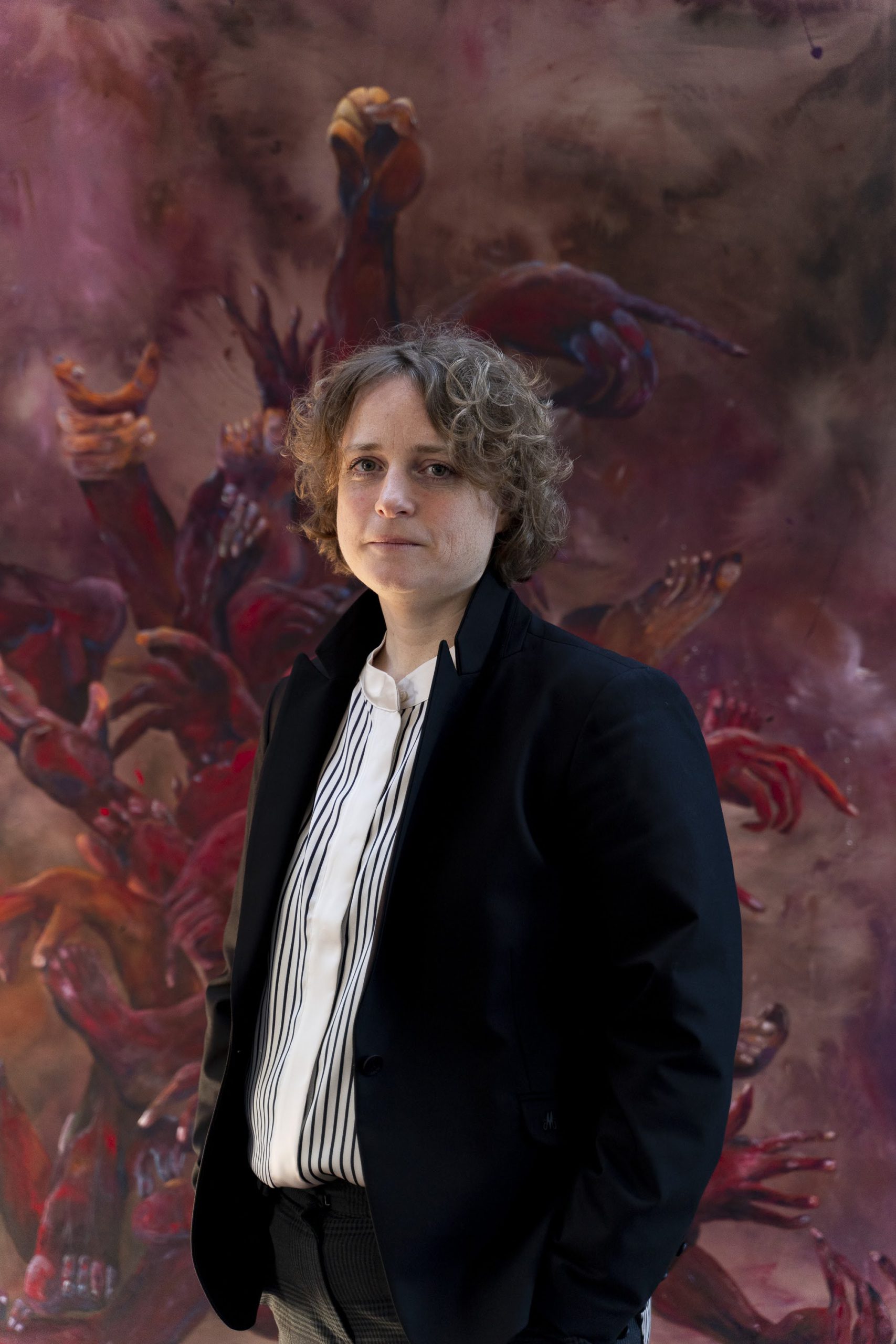
Thus Spake Cassandra’s Sisters
By David Blum
En sandsigerskes sindelag III, 190x150cm, acrylic and polymer on canvas, 2022 by Henriette Hellstern – photographer Rine Rodin
“It crossed my mind,” Henriette Hellstern responds. We chuckle once more over the humorous yet frustrating similarities that inspired her to take on the role of curator for the first installment Cassandra’s sisters by a group of the same name. That’s the kind of energy a Zoom call with an artist installing her works in Rundetaarn can have.
If you need a quick recap on the Greek tragedies, Cassandra was the unfortunate daughter of Troy. ‘Cursed’ with beauty so inspiring as to attract Apollo. After deciding that more than gifts and intense lust were necessary to win her over, Apollo cursed her with an ironic gift: crystal clear divination, the ability to see the future, yet no one would believe her foretelling.
A Cassandra of Our Own
Henriette was born in her very own Greek mythos, one with a bit of tragedy and flair. Molsbjergene in her time was something a bit different – a sort of colony by the Inner Mission, a Lutheran Fundamentalist organization that in many ways takes the classic spin of a highly religious settlement of old, but in the 20/21st century. And as you may have imagined, the LGBTI+ discourse was not exactly booming. The opposite – a don’t ask, don’t tell heaven.
Though Henriette was perhaps already then cursed to look onwards – not enthralled by a particular expectation – she took her family home of artists’ inclinations with her to the Funen Art Academy in Odense. There, as the story goes, she explores her lesbian sexuality through art and the many ways in which one can live, on the other side of Troy.
But this isn’t a feel-good story, as the tragedy in any good Greek tale usually overstays its welcome.
Cassandra is one of us
“She was never going to be listened to in any meaningful way,” she admits, as some inevitable deep talk over the meaning of Cassandra ensues. A beautiful, talented, shrewd, ambitious (in some versions at least), and edgy princess, who doesn’t fall to her knees for any divinity, was never going to be heard, especially in a realm dominated by men. In a culture dominated by truth-seers, having a complicated relationship with one’s role in life means more than any accurate predictions. At least in Ancient Greece.
Henriette isn’t a typical Academy artist. Her art is not complete chaos, and it isn’t pure beauty. In a strange land, you’d call it masculine – but throughout her career, it’s been called everything synonymous. Intense, rough. I just find it quite relevant. We agreed that you could easily see a lot of modern politics in her art. Not just as one of the few invited for the “Nasty Women” exhibition in response to Donald “The Pussygrabber” Trump’s comments concerning Hilary Clinton at the time – but also something deeper.
There’s a lot of tension between some pretty encompassing concepts – an exploration of dichotomies that ought to be in harmony, like the environment and the political person, to form community whilst keeping oneself true, the raw sexual expression of an artist and how it’s often restrained under our artistic canon of forms. And it often takes the form of anatomy turned plantlike – in part due to her interest in such, but also the quaint commentary of women’s traditional role in art, not so long ago.
Strong insight, raw expression, and yet still about herself.
Most of us LGBTI+ Cassandra Complex-types can already tell how that would affect someone’s career. A hard road is the short version.
Around 2400 years ago, someone had the cultural insight to note how a woman choosing her own road, would inevitably gain some pretty tremendous foresight – but in doing so, ended up ridiculed. Nowadays, you tell me what’s changed. Pronouns are still a hot topic in school, unconscious bias in the workplace is still but a “political” topic and judging how the United States are dealing with Critical Theory, it all seems like one can foresee something worrying on the horizon.

A second chance for Cassandra
“So, who is Cassandra?” I ask Henriette.
“As a feminist? She’s the herald of so many awesome tales of undermining, history is full of medical hysteria concerning women that might just have a different temperament than most. As an artist? I think we have an easy time getting her. She knew so much yet wasn’t taken seriously – and yet she still made it her ‘thing’.”
Cassandra never married. When she was raped by Ajax the Lesser, she was hiding, praying in the temple of the asexual Goddess of Wisdom and Intellect, Athena. As a result, the Gods saw to it that his ship crashed – though not before he could boast of his survival – not foreseeing a hidden wave behind him.
Nowadays, an entire group of female artists are developing and empowering their art specifically as a collective of people not yet noticed for their work. Their memories and narratives were reclaimed and put into the center of myriad discussions about the intellect of those that tread another path. Back in 2015, 73% of the exhibited artists at galleries in Denmark were men, and in auctions, 2% of the art on purchase was by women – and sold at a cheaper price.
Henriette said it best herself: “I was put in the closet twice.” When she came out in her late teens, there wasn’t much love to be found back home. When she came out as an artist at the academy in 2006-2011, there wasn’t much space for her either.
“Why is it that artists are so inspired by the Greek tales?” We’re running late, so my instinct is to hope for a beautiful bookend, and Henriette delivers.
“Maybe it is because we learn it in high school, where we feel the need to attach. But maybe it is because whilst we all know the stories, they’re sufficiently old enough that we can reinterpret them. Try again. Give it another shot.”
INFO
If you’re interested in seeing the work of Henriette Hellstern and her ‘sisters’ for yourself, or maybe invest in contemporary art, you can find Cassandra’s sisters – the painters of the future lift the curse inside Rundetaarn (Købmagergade 52A, Copenhagen) from 30 April until 16 June 2022. Helle Moalem and Anna Walther are cofunders with Henriette Hellstern. The exhibition is curated by Anna Walther and Henriette Hellstern.
Also, the art book Cassandras sisters – the painters of the future lift the curse with 15 artist portraits by art historian Natalia Gutman, photos by Rine Rodin and graphics by Anders Gerning will be available for purchase at Rundetaarn’s shop during the exhibition period.



